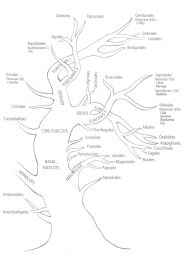
C. taliensis, adapted by Beatrice Häsler from Fig. 331 of The Flora of China (Ming & Bartholomew 2007)
Camellia irrawadiensis Barua is a synonym of C. taliensis (W.W.Sm) Melch. [大理茶 da li cha]. But the former is chemically different from the latter and thus may represent a chemotype. C. taliensis, a wild tea especially important in Yunnan, is characterized by an unusal kind of ellagitannin, namely 1,2-di-O-galloyl-4,6-O-(S)-hexahydroxydiphenoyl-b-D- glucose, not detectable in C. sinensis. Furthermore, it contains much caffeine (>2 % d. wt). The chemotype 'irrawadiensis', however, accumulates theobromine (>1 %) in place of caffeine (Nagata & Sakai, 1985; Yagi et al. 2009) and the specific ellagitannin by a factor of ca 3.5 as compared to 'taliensis' (Yagi et al. 2009).
Since both coffee and tea may have escorted Homo sapiens from the very beginning and therefore strongly influenced human performance and health, life science researchers are encouraged not only to track down the related phytochemical structures but also to breed for an optimum medicinal and bio-regulatory "cocktail". For instance, C. taliensis [akame] was crossed with C. sinensis var. sinensis to gain among the offspring an anthocyanin-rich vigorous hybrid, 'Cha Chuukanbohon Nou 6', used in further studies (Ogino et al. 2005). This cultivar phytochemically resembles 'irrawadiensis' to some extent as it accumulates the above-mentioned ellagitannin at about the same, and theogallin at a much higher range. However as to PuA, it is quite similar to the parent C. sinensis var. sinensis (Honma et al., 2010), i.e. it contains caffeine ≥ 2.5% and only little theobromine.
From the chemotype 'irrawadiensis' we may infer that C. taliensis, besides the anthocyanin variability, represents a "caffeine-species" with a highly variable PuA character – known of Ilex paraguariensis, the mate tea, – and thus marks a target also for creating a caffeine-less or even caffeine-free tea.
Recently, the isolation of microsatellite markers from da li cha has been reported by Yang et al. 2009.
da li cha
The 'Caffeines'
The
Caffeine Plants


